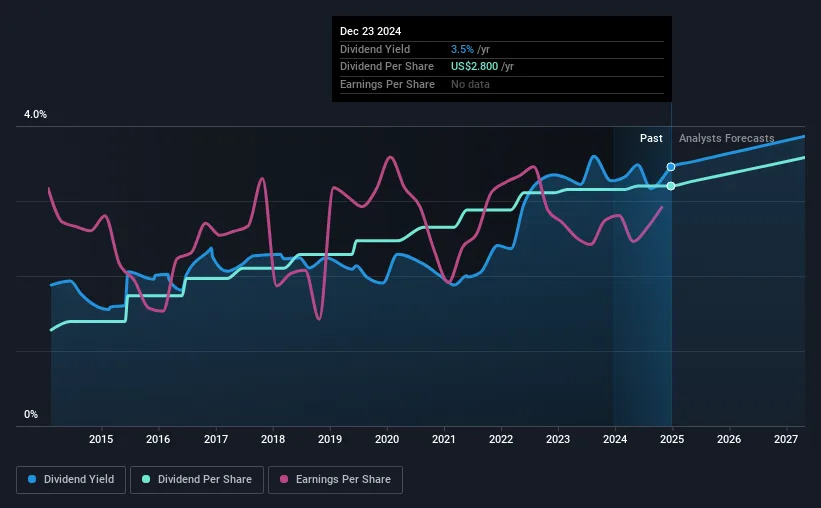December 23, 2024

Medtronic plc ( NYSE:MDT ) stock is about to trade ex-dividend in 3 days. The ex-dividend date is one business day before the record date, which is the cut-off date for shareholders to be present on the company's books to be eligible for a dividend payment. The ex-dividend date is of consequence because whenever a stock is bought or sold, the trade takes at least two business day to settle. In other words, investors can purchase Medtronic's shares before the 27th of December in order to be eligible for the dividend, which will be paid on the 10th of January.
The company's upcoming dividend is US$0.70 a share, following on from the last 12 months, when the company distributed a total of US$2.80 per share to shareholders. Last year's total dividend payments show that Medtronic has a trailing yield of 3.5% on the current share price of US$81.03. Dividends are a major contributor to investment returns for long term holders, but only if the dividend continues to be paid. So we need to investigate whether Medtronic can afford its dividend, and if the dividend could grow.
See our latest analysis for Medtronic
Dividends are typically paid out of company income, so if a company pays out more than it earned, its dividend is usually at a higher risk of being cut. It paid out 85% of its earnings as dividends last year, which is not unreasonable, but limits reinvestment in the business and leaves the dividend vulnerable to a business downturn. We'd be worried about the risk of a drop in earnings. Yet cash flow is typically more important than profit for assessing dividend sustainability, so we should always check if the company generated enough cash to afford its dividend. It paid out more than half (66%) of its free cash flow in the past year, which is within an average range for most companies.
It's positive to see that Medtronic's dividend is covered by both profits and cash flow, since this is generally a sign that the dividend is sustainable, and a lower payout ratio usually suggests a greater margin of safety before the dividend gets cut.
Click here to see the company's payout ratio, plus analyst estimates of its future dividends.
Stocks with flat earnings can still be attractive dividend payers, but it is important to be more conservative with your approach and demand a greater margin for safety when it comes to dividend sustainability. If business enters a downturn and the dividend is cut, the company could see its value fall precipitously. With that in mind, we're not enthused to see that Medtronic's earnings per share have remained effectively flat over the past five years. It's better than seeing them drop, certainly, but over the long term, all of the best dividend stocks are able to meaningfully grow their earnings per share.
Another key way to measure a company's dividend prospects is by measuring its historical rate of dividend growth. In the last 10 years, Medtronic has lifted its dividend by approximately 9.6% a year on average.
Should investors buy Medtronic for the upcoming dividend? Medtronic has been unable to generate earnings growth, but at least its dividend looks sustainable, with its profit and cashflow payout ratios within reasonable limits. Bottom line: Medtronic has some unfortunate characteristics that we think could lead to sub-optimal outcomes for dividend investors.
So if you're still interested in Medtronic despite it's poor dividend qualities, you should be well informed on some of the risks facing this stock. In terms of investment risks, we've identified 1 warning signwith Medtronic and understanding them should be part of your investment process.
A common investing mistake is buying the first interesting stock you see. Here you can find a full list of high-yield dividend stocks.
Have feedback on this article? Concerned about the content?
Get in touch
with us directly.
Alternatively, email editorial-team (at) simplywallst.com.
This article by Simply Wall St is general in nature.
We provide commentary based on historical data and analyst forecasts only using an unbiased methodology and our articles are not intended to be financial advice.
It does not constitute a recommendation to buy or sell any stock, and does not take account of your objectives, or your financial situation. We aim to bring you long-term focused analysis driven by fundamental data. Note that our analysis may not factor in the latest price-sensitive company announcements or qualitative material. Simply Wall St has no position in any stocks mentioned.